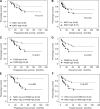Fatty acid synthase expression associated with NAC1 is a potential therapeutic target in ovarian clear cell carcinomas
- PMID: 22653145
- PMCID: PMC3394978
- DOI: 10.1038/bjc.2012.246
Fatty acid synthase expression associated with NAC1 is a potential therapeutic target in ovarian clear cell carcinomas
Abstract
Background: This study examined the clinical significance of NAC1 and the expression level of its potential downstream target fatty acid synthase (FASN) in ovarian clear cell carcinomas (OCCCs), and evaluated the NAC1/FASN pathway as a potential therapeutic target.
Methods: NAC1 and FASN expression and NACC1 gene amplification were assessed in ovarian cancers by immunohistochemistry, fluorescence in situ hybridisation, and clinical data collected by a retrospective chart review. C75, a FASN inhibitor, was used to assess whether this pathway represented a therapeutic target in OCCC.
Results: High NAC1 expression was most frequent in clear cell tumours (40.0%:24/60). NACC1 gene amplification was identified in none of the 58 OCCCs. The frequency of NACC1 gene amplification was significantly higher in the high-grade serous histology than in the clear cell histology (P<0.01). NAC1 expression was significantly correlated with FASN expression in both OCCC samples and OCCC cell lines. Either high NAC1 expression or high FASN expression significantly correlated with shorter progression-free and overall survival (P=0.002 and 0.0048). NAC1 overexpression stimulated FASN expression, and NAC1 silencing using siRNA decreased FASN expression in OCCC cell lines. Profound growth inhibition was observed in C75-treated carcinoma cells with FASN overexpression when compared with the response in carcinoma cells without FASN expression.
Conclusion: These findings indicate that NAC1/FASN overexpression is critical to the growth and survival of a subset of OCCC. The FASN silencing by the C75-induced phenotypes depends on the expression status of the targeted cell line. Therefore, NAC1/FASN pathway-targeted therapy may benefit selected OCCC patients.
Conflict of interest statement
The authors declare no conflict of interest.
Figures



Similar articles
-
Biological role and prognostic significance of NAC1 in ovarian cancer.Gynecol Oncol. 2010 Dec;119(3):469-78. doi: 10.1016/j.ygyno.2010.08.031. Epub 2010 Sep 24. Gynecol Oncol. 2010. PMID: 20869761
-
Prognostic and therapeutic impact of the chromosome 20q13.2 ZNF217 locus amplification in ovarian clear cell carcinoma.Cancer. 2012 Jun 1;118(11):2846-57. doi: 10.1002/cncr.26598. Epub 2011 Dec 2. Cancer. 2012. PMID: 22139760
-
c-MET as a Potential Therapeutic Target in Ovarian Clear Cell Carcinoma.Sci Rep. 2016 Dec 5;6:38502. doi: 10.1038/srep38502. Sci Rep. 2016. PMID: 27917934 Free PMC article.
-
Fatty acid synthase: A key driver of ovarian cancer metastasis and a promising therapeutic target.Pathol Res Pract. 2024 Aug;260:155465. doi: 10.1016/j.prp.2024.155465. Epub 2024 Jul 14. Pathol Res Pract. 2024. PMID: 39018927 Review.
-
Pharmacological inhibitors of Fatty Acid Synthase (FASN)--catalyzed endogenous fatty acid biogenesis: a new family of anti-cancer agents?Curr Pharm Biotechnol. 2006 Dec;7(6):483-93. doi: 10.2174/138920106779116928. Curr Pharm Biotechnol. 2006. PMID: 17168665 Review.
Cited by
-
Metabolic Regulation of Apoptosis in Cancer.Int Rev Cell Mol Biol. 2016;327:43-87. doi: 10.1016/bs.ircmb.2016.06.006. Epub 2016 Jul 30. Int Rev Cell Mol Biol. 2016. PMID: 27692180 Free PMC article. Review.
-
SIK2 enhances synthesis of fatty acid and cholesterol in ovarian cancer cells and tumor growth through PI3K/Akt signaling pathway.Cell Death Dis. 2020 Jan 13;11(1):25. doi: 10.1038/s41419-019-2221-x. Cell Death Dis. 2020. PMID: 31932581 Free PMC article.
-
NIPBL::NACC1 Fusion Hepatic Carcinoma.Am J Surg Pathol. 2024 Feb 1;48(2):183-193. doi: 10.1097/PAS.0000000000002159. Epub 2023 Dec 4. Am J Surg Pathol. 2024. PMID: 38047392 Free PMC article.
-
Metabolic fitness of NAC1-deficient Tregs in the tumor microenvironment fuels tumor growth.JCI Insight. 2025 Jan 7;10(4):e186000. doi: 10.1172/jci.insight.186000. JCI Insight. 2025. PMID: 39773913 Free PMC article.
-
Ectopic Otoconin 90 expression in triple negative breast cancer cell lines is associated with metastasis functions.PLoS One. 2019 Feb 14;14(2):e0211737. doi: 10.1371/journal.pone.0211737. eCollection 2019. PLoS One. 2019. PMID: 30763339 Free PMC article.
References
-
- Alo PL, Visca P, Framarino ML, Botti C, Monaco S, Sebastiani V, Serpieri DE, Di Tondo U (2000) Immunohistochemical study of fatty acid synthase in ovarian neoplasms. Oncol Rep 7: 1383–1388 - PubMed
-
- Alo PL, Visca P, Marci A, Mangoni A, Botti C, Di Tondo U (1996) Expression of fatty acid synthase (FAS) as a predictor of recurrence in stage I breast carcinoma patients. Cancer 77: 474–482 - PubMed
Publication types
MeSH terms
Substances
LinkOut - more resources
Full Text Sources
Medical
Research Materials
Miscellaneous

